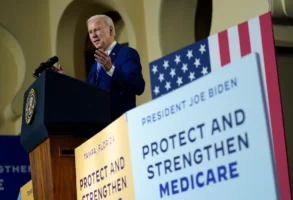
Published May 16, 2019
President Trump has unveiled a new immigration proposal that would change the emphasis for admitting legal immigrants from family ties to economic skills. That’s a good move, but the plan still inadequately deals with how to control illegal immigration. To do that, the president needs to learn some lessons from another long-standing federal effort: the war on drugs.
The war on drugs might seem like an odd example for a comparison. Aside from the obvious difference — our immigration crisis is about people fleeing violence and economic hardship for a better life in the United States, whereas the drug war is about trying to prevent brutal criminals from feeding dangerous substances into our country — the two issues share a common conceptual theme: Policymakers have wrongly focused on the supply side of the equation rather than the demand side.
We have generally tried to combat the flow of low-skilled, undocumented immigrants in a manner similar to that which has failed to stem the flow of illegal drugs. We try to prop up weak economies in Central America and South America to hopefully give people less reason to come. We try to stop them at the border so they don’t get here in the first place. And we raid employers and bust them if we find they are employing undocumented immigrants, always hoping the next arrest will be the last one. And, as in the war on drugs, the supply of undocumented immigrants remains.
In both cases, basic economics teaches that as long as the demand for a good is high, people will try to supply it — even as the price rises. Some immigrants might be dissuaded from undertaking the risky journey north as news of greater enforcement trickles back to their homes, but minimum wages in the United States ranging from $7.25 to as much as $15 still lure many who face paltry pay in their own country — or no work at all. Some U.S. employers might be dissuaded from hiring workers who they suspect are not here legally, but the risk of getting caught remains low, and the short-term advantage of having cheap, readily available and compliant workers usually outweighs the risks.
Building a physical wall or barrier will surely reduce this flow, but it will continue as long as it remains so economically advantageous for workers and employers. Risky boat crossings from Mexico to the Texas coast will replace risky land crossings over the U.S.-Mexico border. And many people who arrive by other means will continue to overstay their visas. These people are desperate for high-paying work.
The president needs to recognize this and make controlling the demand for these workers as important as interdicting their supply. As I’ve said before, mandatory use of E-Verify, the government system that checks documents provided by prospective employees that supposedly prove legal status against government records, is an absolute minimum. He should also form a program similar to the Energy Star system for appliances that would allow compliant employers to advertise their use of the system. But he shouldn’t stop there.
The government could require employers to provide Social Security numbers for every person whose wages and expenses they seek to deduct. It could then check those numbers against E-Verify and disallow deductions for numbers that don’t check out. Those who seek to deduct payments for nannies could be required to do the same, and those who use companies to provide their nannies or other home-help personnel could receive tax benefits only if those firms were themselves compliant. Measures like these would provide strong economic incentives for employers to hire only legal immigrants.
The administration could go further still and crack down on the money that many undocumented workers send to their home countries. About $48 billion was sent home by workers from El Salvador, Honduras, Guatemala and Mexico in 2017, according to the World Bank. Much of this money is transferred via wire from the United States. That’s money earned illegally in this country that is being sent out — a significant motivating force for illegal immigration. A plan that seriously tries to reduce undocumented immigration would try to reduce or stop these remittances, perhaps by requiring wire service firms to use E-Verify for any individual-to-individual monetary transfer.
Many conservatives fear any comprehensive immigration deal because they say the problem of illegal immigration won’t be permanently solved. They are right; the war on drugs taught us that we can get only so far by reducing supply. Any deal that finally gets enacted must include more than “amnesty for the wall” to garner conservative support. If it doesn’t, then we’ll just have to do it all over again in 30 years — but by then, many Americans won’t be in a mood to compromise.
Henry Olsen is a Washington Post columnist and a senior fellow at the Ethics and Public Policy Center.







